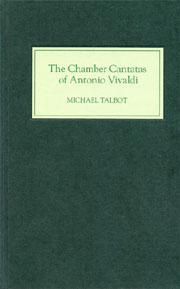Book contents
- Frontmatter
- Contents
- List of music examples
- List of tables
- Preface
- Conventions and abbreviations
- 1 The Rediscovery of Vivaldi's Cantatas
- 2 The Cantata Genre
- 3 Vivaldi and the Voice
- 4 The Mantuan Cantatas
- 5 Cantatas of the Middle Years
- 6 The Dresden Cantatas
- 7 Vivaldi's Cantatas in Perspective
- Glossary
- List of Vivaldi's cantatas published in the New Critical Edition
- Spurious works
- Bibliography
- Index to musical works
- General index
3 - Vivaldi and the Voice
Published online by Cambridge University Press: 12 September 2012
- Frontmatter
- Contents
- List of music examples
- List of tables
- Preface
- Conventions and abbreviations
- 1 The Rediscovery of Vivaldi's Cantatas
- 2 The Cantata Genre
- 3 Vivaldi and the Voice
- 4 The Mantuan Cantatas
- 5 Cantatas of the Middle Years
- 6 The Dresden Cantatas
- 7 Vivaldi's Cantatas in Perspective
- Glossary
- List of Vivaldi's cantatas published in the New Critical Edition
- Spurious works
- Bibliography
- Index to musical works
- General index
Summary
The Composer and the Text
Whether or not he had been much exposed to vocal music previously, Vivaldi became immersed in it from his teenage years onwards. He trained as a priest from 1693 to 1703, and this experience must have left him with a thorough knowledge of both canto fermo (plainsong) and canto figurato (figural music – the catch-all term for composed sacred vocal music). His work as a jobbing violinist alongside his father, Giovanni Battista Vivaldi (c.1655–1736), must have introduced him to countless sacred and operatic works; his first known public appearance as a violinist was at Christmas 1696, when he was engaged as a supernumerary player at the ducal church of S. Marco. Giovanni Battista, if he is identical with the Giambattista Rossi who composed a short dramatic work, La fedeltà sfortunata, in 1688, may even have possessed a composer's understanding of vocal music himself. It cannot be stressed enough that until the 1710s – perhaps, more exactly, until the publication of Antonio's L'estro armonico concertos in 1711 – Giovanni Battista was the ‘senior partner’ of the two in status as well as in age. He must have been a massive formative influence. His loyalty to Antonio's interests – with which, of course, his own and those of the whole Vivaldi family were bound up – caused him later to serve his son almost until his death (which occurred not many years before Antonio's own) as a diligent and reliable copyist, and perhaps also as an accompanist and partner in performances.
- Type
- Chapter
- Information
- The Chamber Cantatas of Antonio Vivaldi , pp. 61 - 88Publisher: Boydell & BrewerPrint publication year: 2006



